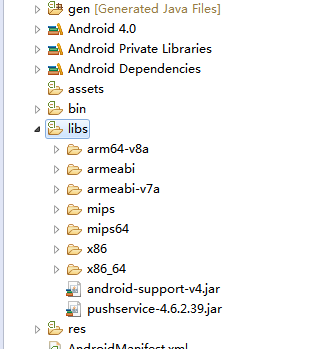在项目中使用推送是在正常不过得了,其实像百度推送,友盟推送等都可以为我们开发者更方便做到推送;推送的原理就不说了,网上有很多。由于我在修改以前的项目,以前使用的是百度云3.2版本,在3.2到4.6其中版本变动不少,改了不少地方就不一一细说了, 就使用最新的吧~~
下载SDK附带demo,我是根据百度推送的api文档自己写了一个demo,先将下载下来的SDK中的libs导入项目中,
然后将申请的key写入配置文件中或者写入公共参数类中,写入配置文件中,是需要通过方法获得的,自带demo中有,然后配置推送所需要的权限
<!-- Push service 运行需要的权限 -->
<uses-permission android:name="android.permission.INTERNET" />
<uses-permission android:name="android.permission.READ_PHONE_STATE" />
<uses-permission android:name="android.permission.ACCESS_NETWORK_STATE" />
<uses-permission android:name="android.permission.RECEIVE_BOOT_COMPLETED" />
<uses-permission android:name="android.permission.WRITE_SETTINGS" />
<uses-permission android:name="android.permission.VIBRATE" />
<uses-permission android:name="android.permission.WRITE_EXTERNAL_STORAGE" />
<uses-permission android:name="android.permission.DISABLE_KEYGUARD" />
<uses-permission android:name="android.permission.ACCESS_COARSE_LOCATION" />
<uses-permission android:name="android.permission.ACCESS_WIFI_STATE" />
<uses-permission android:name="android.permission.ACCESS_DOWNLOAD_MANAGER" />
<uses-permission android:name="android.permission.DOWNLOAD_WITHOUT_NOTIFICATION" />
<uses-permission android:name="android.permission.EXPAND_STATUS_BAR" />根据文档将需要配置的推送服务等直接复制进去
<!-- push service start -->
<!-- 用于接收系统消息以保证PushService正常运行 -->
<receiver
android:name="com.baidu.android.pushservice.PushServiceReceiver"
android:process=":bdservice_v1" >
<intent-filter>
<action android:name="android.intent.action.BOOT_COMPLETED" />
<action android:name="android.net.conn.CONNECTIVITY_CHANGE" />
<action android:name="com.baidu.android.pushservice.action.notification.SHOW" />
<action android:name="com.baidu.android.pushservice.action.media.CLICK" />
<!-- 以下四项为可选的action声明,可大大提高service存活率和消息到达速度 -->
<action android:name="android.intent.action.MEDIA_MOUNTED" />
<action android:name="android.intent.action.USER_PRESENT" />
<action android:name="android.intent.action.ACTION_POWER_CONNECTED" />
<action android:name="android.intent.action.ACTION_POWER_DISCONNECTED" />
</intent-filter>
</receiver>
<!-- Push服务接收客户端发送的各种请求 -->
<receiver
android:name="com.baidu.android.pushservice.RegistrationReceiver"
android:process=":bdservice_v1" >
<intent-filter>
<action android:name="com.baidu.android.pushservice.action.METHOD" />
<action android:name="com.baidu.android.pushservice.action.BIND_SYNC" />
</intent-filter>
<intent-filter>
<action android:name="android.intent.action.PACKAGE_REMOVED" />
<data android:scheme="package" />
</intent-filter>
</receiver>
<service
android:name="com.baidu.android.pushservice.PushService"
android:exported="true"
android:process=":bdservice_v1" >
<intent-filter>
<action android:name="com.baidu.android.pushservice.action.PUSH_SERVICE" />
</intent-filter>
</service>
<!-- 4.4版本新增的CommandService声明,提升小米和魅族手机上的实际推送到达率 -->
<service
android:name="com.baidu.android.pushservice.CommandService"
android:exported="true" />
<!-- push结束 -->
<!-- 4.6版本新增的Activity声明,提升Push后台存活率 -->
<activity
android:name="com.baidu.android.pushservice.PushKeepAlive"
android:launchMode="singleInstance"
android:theme="@android:style/Theme.Translucent.NoTitleBar" />PushManager.startWork(getApplicationContext(),
PushConstants.LOGIN_TYPE_API_KEY, API_KEY);百度推送提供PushMessageReceiver并且重载所有的回调函数,如下:
/**
* 调用PushManager.startWork后,sdk将对push
* server发起绑定请求,这个过程是异步的。绑定请求的结果通过onBind返回。 如果您需要用单播推送,需要把这里获取的channel
* id和user id上传到应用server中,再调用server接口用channel id和user id给单个手机或者用户推送。
*
* @param context
* BroadcastReceiver的执行Context
* @param errorCode
* 绑定接口返回值,0 - 成功
* @param appid
* 应用id。errorCode非0时为null
* @param userId
* 应用user id。errorCode非0时为null
* @param channelId
* 应用channel id。errorCode非0时为null
* @param requestId
* 向服务端发起的请求id。在追查问题时有用;
* @return none
*/
@Override
public void onBind(Context context, int errorCode, String appid,
String userId, String channelId, String requestId) {
String responseString = "onBind errorCode=" + errorCode + " appid="
+ appid + " userId=" + userId + " channelId=" + channelId
+ " requestId=" + requestId;
Log.d(TAG, responseString);
if (errorCode == 0) {
// 绑定成功
Log.d(TAG, "绑定成功");
}
// Demo更新界面展示代码,应用请在这里加入自己的处理逻辑
updateContent(context, responseString);
}
/**
* 接收透传消息的函数。
*
* @param context
* 上下文
* @param message
* 推送的消息
* @param customContentString
* 自定义内容,为空或者json字符串
*/
@Override
public void onMessage(Context context, String message,
String customContentString) {
String messageString = "透传消息 message=\"" + message
+ "\" customContentString=" + customContentString;
Log.d(TAG, messageString);
// 自定义内容获取方式,mykey和myvalue对应透传消息推送时自定义内容中设置的键和值
if (!TextUtils.isEmpty(customContentString)) {
JSONObject customJson = null;
try {
customJson = new JSONObject(customContentString);
String myvalue = null;
if (!customJson.isNull("mykey")) {
myvalue = customJson.getString("mykey");
}
} catch (JSONException e) {
// TODO Auto-generated catch block
e.printStackTrace();
}
}
// Demo更新界面展示代码,应用请在这里加入自己的处理逻辑
updateContent(context, messageString);
}
/**
* 接收通知点击的函数。
*
* @param context
* 上下文
* @param title
* 推送的通知的标题
* @param description
* 推送的通知的描述
* @param customContentString
* 自定义内容,为空或者json字符串
*/
@Override
public void onNotificationClicked(Context context, String title,
String description, String customContentString) {
String notifyString = "通知点击 title=\"" + title + "\" description=\""
+ description + "\" customContent=" + customContentString;
Log.d(TAG, notifyString);
// 自定义内容获取方式,mykey和myvalue对应通知推送时自定义内容中设置的键和值
if (!TextUtils.isEmpty(customContentString)) {
JSONObject customJson = null;
try {
customJson = new JSONObject(customContentString);
String myvalue = null;
if (!customJson.isNull("mykey")) {
myvalue = customJson.getString("mykey");
}
} catch (JSONException e) {
// TODO Auto-generated catch block
e.printStackTrace();
}
}
// Demo更新界面展示代码,应用请在这里加入自己的处理逻辑
updateContent(context, notifyString);
}
/**
* 接收通知到达的函数。
*
* @param context
* 上下文
* @param title
* 推送的通知的标题
* @param description
* 推送的通知的描述
* @param customContentString
* 自定义内容,为空或者json字符串
*/
@Override
public void onNotificationArrived(Context context, String title,
String description, String customContentString) {
Toast.makeText(context, "通知到达了", 0).show();
String notifyString = "onNotificationArrived title=\"" + title
+ "\" description=\"" + description + "\" customContent="
+ customContentString;
Log.d(TAG, notifyString);
// 自定义内容获取方式,mykey和myvalue对应通知推送时自定义内容中设置的键和值
if (!TextUtils.isEmpty(customContentString)) {
JSONObject customJson = null;
try {
customJson = new JSONObject(customContentString);
String myvalue = null;
if (!customJson.isNull("mykey")) {
myvalue = customJson.getString("mykey");
}
} catch (JSONException e) {
// TODO Auto-generated catch block
e.printStackTrace();
}
}
// Demo更新界面展示代码,应用请在这里加入自己的处理逻辑
// 你可以參考 onNotificationClicked中的提示从自定义内容获取具体值
updateContent(context, notifyString);
}
/**
* setTags() 的回调函数。
*
* @param context
* 上下文
* @param errorCode
* 错误码。0表示某些tag已经设置成功;非0表示所有tag的设置均失败。
* @param successTags
* 设置成功的tag
* @param failTags
* 设置失败的tag
* @param requestId
* 分配给对云推送的请求的id
*/
@Override
public void onSetTags(Context context, int errorCode,
List<String> sucessTags, List<String> failTags, String requestId) {
String responseString = "onSetTags errorCode=" + errorCode
+ " sucessTags=" + sucessTags + " failTags=" + failTags
+ " requestId=" + requestId;
Log.d(TAG, responseString);
// Demo更新界面展示代码,应用请在这里加入自己的处理逻辑
updateContent(context, responseString);
}
/**
* delTags() 的回调函数。
*
* @param context
* 上下文
* @param errorCode
* 错误码。0表示某些tag已经删除成功;非0表示所有tag均删除失败。
* @param successTags
* 成功删除的tag
* @param failTags
* 删除失败的tag
* @param requestId
* 分配给对云推送的请求的id
*/
@Override
public void onDelTags(Context context, int errorCode,
List<String> sucessTags, List<String> failTags, String requestId) {
String responseString = "onDelTags errorCode=" + errorCode
+ " sucessTags=" + sucessTags + " failTags=" + failTags
+ " requestId=" + requestId;
Log.d(TAG, responseString);
// Demo更新界面展示代码,应用请在这里加入自己的处理逻辑
updateContent(context, responseString);
}
/**
* listTags() 的回调函数。
*
* @param context
* 上下文
* @param errorCode
* 错误码。0表示列举tag成功;非0表示失败。
* @param tags
* 当前应用设置的所有tag。
* @param requestId
* 分配给对云推送的请求的id
*/
@Override
public void onListTags(Context context, int errorCode, List<String> tags,
String requestId) {
String responseString = "onListTags errorCode=" + errorCode + " tags="
+ tags;
Log.d(TAG, responseString);
// Demo更新界面展示代码,应用请在这里加入自己的处理逻辑
updateContent(context, responseString);
}
/**
* PushManager.stopWork() 的回调函数。
*
* @param context
* 上下文
* @param errorCode
* 错误码。0表示从云推送解绑定成功;非0表示失败。
* @param requestId
* 分配给对云推送的请求的id
*/
@Override
public void onUnbind(Context context, int errorCode, String requestId) {
String responseString = "onUnbind errorCode=" + errorCode
+ " requestId = " + requestId;
Log.d(TAG, responseString);
if (errorCode == 0) {
// 解绑定成功
Log.d(TAG, "解绑成功");
}
// Demo更新界面展示代码,应用请在这里加入自己的处理逻辑
updateContent(context, responseString);
}然后将该方法在配置中注册;
<!-- 自定义receiver处理百度推送 -->
<receiver android:name=".MyBaiDuPushReceiver" >
<intent-filter>
<!-- 接收push消息 -->
<action android:name="com.baidu.android.pushservice.action.MESSAGE" />
<!-- 接收bind、setTags等method的返回结果 -->
<action android:name="com.baidu.android.pushservice.action.RECEIVE" />
<!-- 接收通知点击事件,和通知自定义内容 -->
<action android:name="com.baidu.android.pushservice.action.notification.CLICK" />
</intent-filter>
</receiver>然后可以通过百度推送提供的控制台来验证你的配置是否成功。
手机安装测试===》
推送成功啦,需要注意的是,如果你在选择推送的用户范围时要注意几点:
1、百度推送所记录的设备数是根据手机的设备号来记录的,并不是记录安装次数,也就是说一台手机不管卸载重装多少次,只要设备号没更改就只记录一次;
2、用户范围:在选择指定设备和标签设备时要根据需求来选择,Channel ID 针对于每个手机是唯一的,你的手机就会被百度推送打上这个ID,推送时只要根据这个id就能推送到具体的某台设备上去;
而标签不仅可以标记某台设备,而且一台设备可以被标记多个标签,比如:推送到某一个小组,或者某一分公司下的所有成员。并且每个应用最多可以定义10000个标签,每个标签对应的设备数没有限制;
更为详细的步骤或者配置方面,可以查阅百度推送api文档:
百度推送API文档


























 290
290

 被折叠的 条评论
为什么被折叠?
被折叠的 条评论
为什么被折叠?








